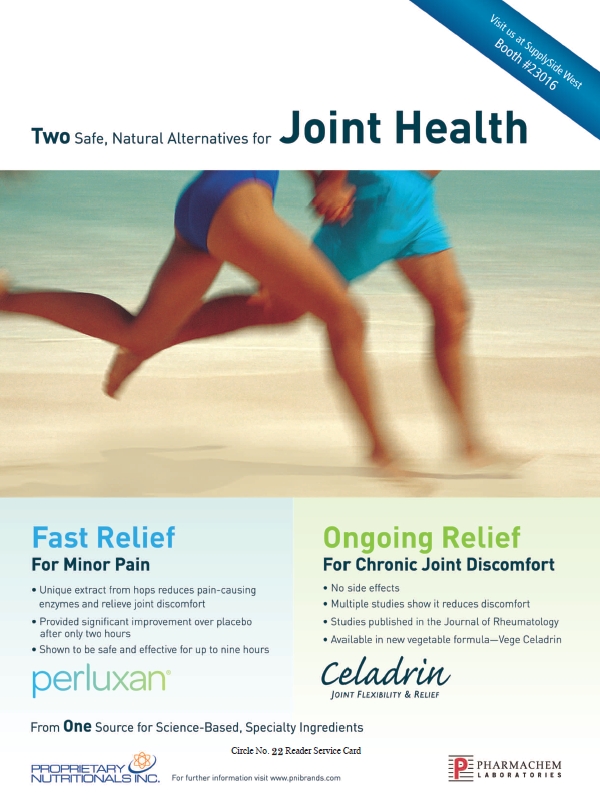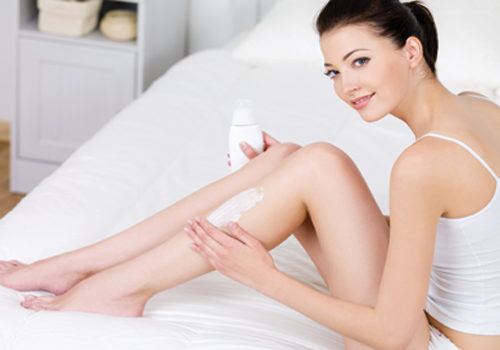Did you know about half of your clientele are suffering in vein? Varicose and spider veins are likely plaguing many of your shoppers…and you can help.
Got the Blues?
About 50% of Americans are affected by varicose veins (1). These bluish, bulging cords run just beneath the surface of skin, usually taking over legs and feet. When inflamed, these veins are extremely sensitive to the touch and cause problems such as itchy skin, swollen ankles and aching in affected limbs. Visibly twisted and swollen, varicose veins can be surrounded by patches of flooded capillaries also known as spider veins.
Varicose veins are often the result of weak or damaged valves in the veins. These valves stop blood from flowing backward and when they become weak, blood can leak into the veins and collect. This makes the veins bigger and, over time, become varicose. Standing for prolonged periods of time, pregnancy, genetics or being overweight increase one’s chances of developing varicose veins.
Spider veins also develop from a backup of blood, but they are often caused by hormonal changes, sun  exposure and injuries.
exposure and injuries.
While not usually a serious health risk, these conditions can be uncomfortable and are unsightly to some.
Learn About Your Options
One option for helping those stricken with varicose and spider veins are topical creams with horse chestnut, which helps moisturize skin and tone tissues and vein appearance (2). Horse chestnut cream is believed to benefit the blood vessels because it contains aescin, which stops the release of enzymes that harm capillary walls.
Some products combine horse chestnut with other circulation-supporting supplements such as witch hazel, vitamin K, butcher’s broom, myrrh and white oak (2). Rutin and citrus bioflavanoids may also help strengthen capillaries (3).
Other options for those with varicose veins are French maritime pine bark (branded as Pycnogenol, Horphag Research), an exceptionally strong antioxidant, and grape seed extract thanks to their oligomeric proanthocyanidin complexes (OPCs) (4). According to one natural skincare company, several studies have concluded that Pycnogenol improves circulation by relaxing constricted blood vessels and strengthening the capillary system. Capillaries that are weak or damaged can leak and retain fluid, leading to impaired circulation. The use of Pycnogenol can promote nourished, well-oxygenated cells. This helps to prevent the swelling of varicose veins and reduces the appearance of spider veins.
The same skincare company recommends following up cleansing with a foot crème that contains tea tree or a skin-friendly oil like jojoba (5). Tea tree oil wash can help relieve and prevent future fungal infections. This natural antiseptic can also help reduce odor-causing bacteria such as athlete’s foot.
Caring for the Diabetic Foot
Although varicose veins can affect anyone, people with diabetes can be more susceptible to problems of the legs and feet. Diabetes.org states that poor circulation within the leg or foot area can be extremely problematic and difficult for diabetics since their condition causes leg and foot blood vessels to narrow and harden (6). The less blood flow to an area, the less able the body is to fight infection.
Infection in the diabetic foot can be caused by something as simple as a tiny cut, an ingrown toenail or a sore (7). As long as feet are properly cared for, these problems have a lesser chance of escalating into a more severe infection.
It’s important to rinse and dry feet and toes thoroughly in order to prevent infection, and your store may have mild skin cleansers suitable for diabetics. Those with high blood glucose levels may also have very dry skin that can crack and lead to infections. A good moisturizer can help keep skin comfortable.
Overall Care
When practicing proper foot and leg care, be sure to trim toenails with clean clippers after feet have been washed and patted dry thoroughly. If feet have any corns or calluses, shoppers can try a pumice stone to smooth skin. Rub gently in one direction. Remember, taking small steps in overcoming the obstacles varicose veins pose can help prevent more severe infections down the road. WF
References
1. WebMD, “What Are Varicose Veins?” Apr. 20, 2012, http://answers.webmd.com/answers/1179178/what-are-varicose-veins, accessed July 10, 2013.
2. Planetary Herbals, “Horse Chestnut Cream,” www.planetaryherbals.com/products/GP1532, accessed July 10, 2013.
3. Reviva Labs, “Spider Vein & Rosacea Day Cream W/Vitamin P,” www.revivalabs.com/newstore/scripts/prodView.asp?idproduct=22, accessed July 23, 2013.
4. derma e, “Pycnogenol,” www.dermae.com/fc_portals/fc_images/article_pdfs/pycnogenol.pdf, accessed July 10, 2013.
5. derma e, “Out of Sight Is Out of Mind,” www.dermae.com/fc_portals/fc_images/article_pdfs/Out_of_Sight_SUNE.pdf, accessed July 10, 2013.
6. American Diabetes Association, “Foot Complications,” www.diabetes.org/living-with-diabetes/complications/foot-complications, accessed July 10, 2013.
Kristin Blake is a freelance writer based in East Hanover, NJ.









